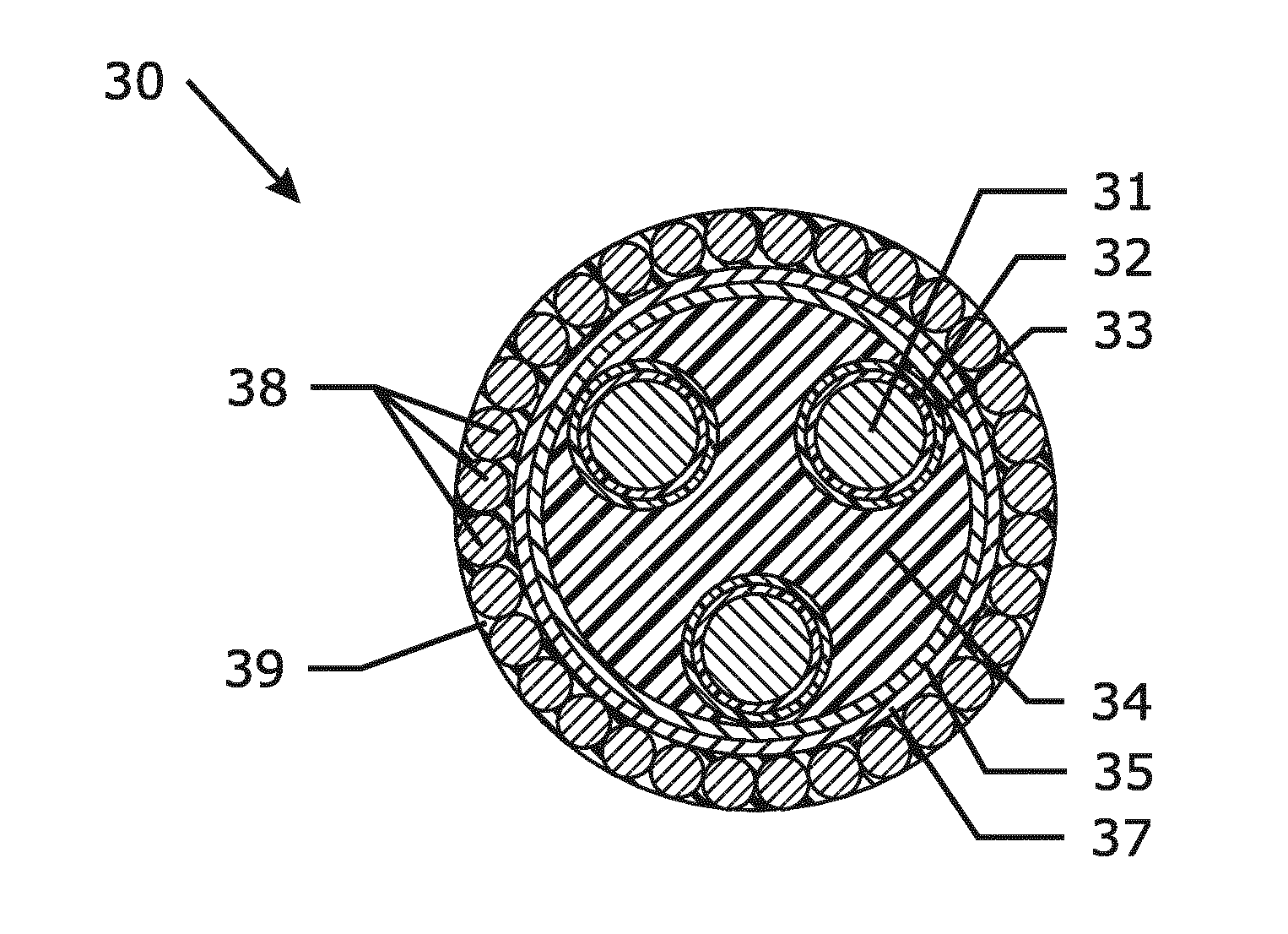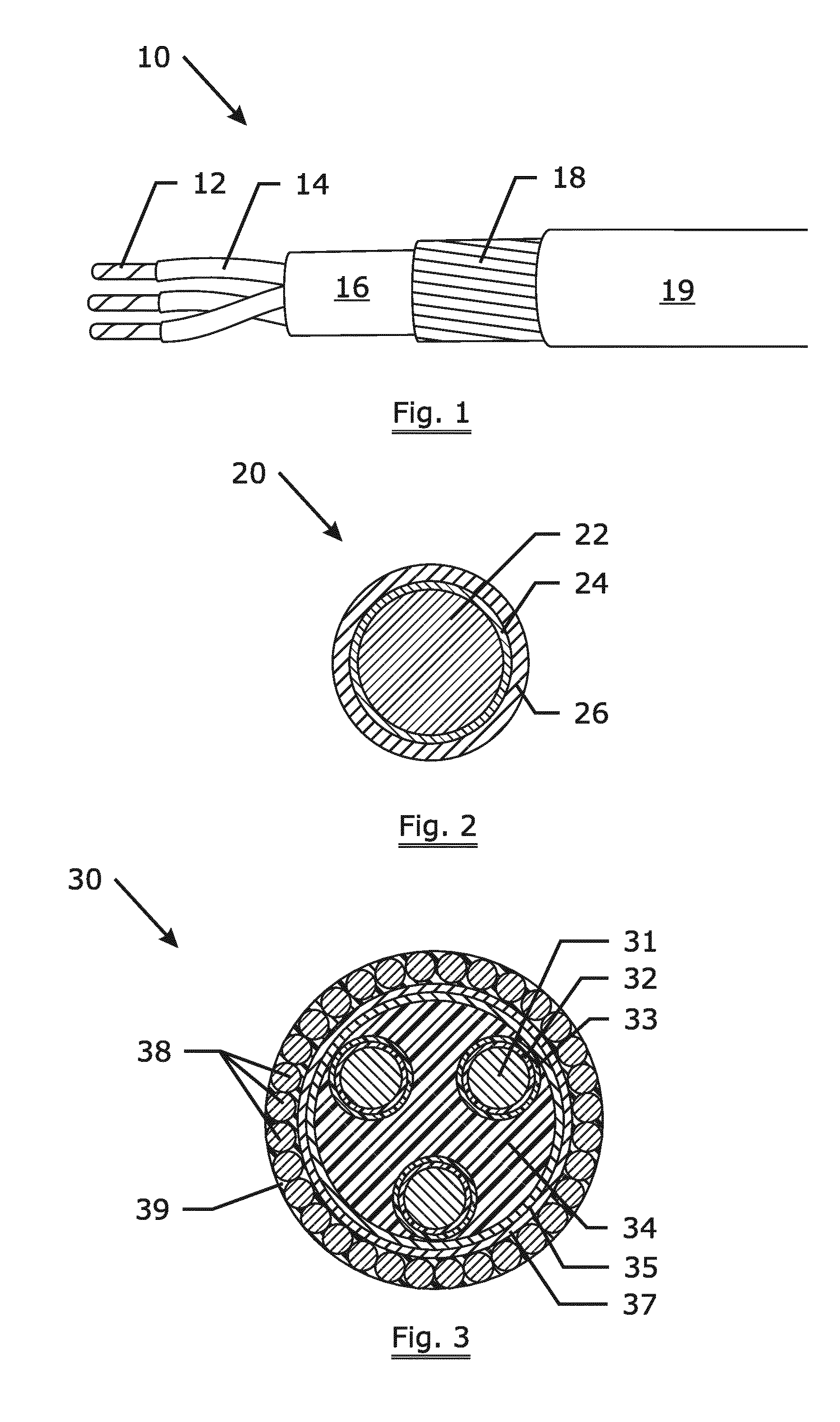Non-magnetic stainless steel wire as an armouring wire for power cables
- Summary
- Abstract
- Description
- Claims
- Application Information
AI Technical Summary
Benefits of technology
Problems solved by technology
Method used
Image
Examples
example 1
[0043]A steel wire, ref. AISI 202, of a diameter of 1.9 mm is treated according to a first embodiment of the process.
[0044]The composition (in percentage by weight) of the wire rod is as follows: C less than 0.08; Si less than 0.75; Mn ranging from 6.6 to 8; P less than 0.045; S less than 0.015; N less than 0.15; Cr ranging from 15 to 17; Ni ranging from 3.5 to 5; Cu less than 2; and the balance is Fe.
[0045]The steel wire is processed continuously on one or more lines depending on the capabilities of the production site.
[0046]This steel wire is first degreased in an degreasing bath (containing phosphoric acid) at 30° C. to 80° C. for a few seconds. An ultrasonic generator is provided in the bath to assist the degreasing.
[0047]Alternatively, the steel wire may be first degreased in an alkaline degreasing bath (containing NaOH) at 30° C. to 80° C. for a few seconds. Electrical assistance is applied in the bath to assist the degreasing.
[0048]This is followed by a pickling step, wherein...
example 2
[0053]A steel wire, ref. AISI 202, of a diameter of 1.9 mm is treated according to a second embodiment of the process.
[0054]This steel wire is first degreased in an acid degreasing bath with the assistance of an ultrasonic generator or degreased in an alkaline degreasing bath with electrical assistance. The steel wire is continued with a pickling step, wherein the steel wire is dipped in a pickling bath (containing 100-500 g / l sulphuric acid) at 20° C. to 30° C. for a few seconds to remove the instantaneously formed chromium oxide. This is followed by another successive pickling carried out by dipping the steel wire in a pickling bath (containing 100-500 g / l sulphuric acid) at 20° C. to 30° C. for a very short time to further and sufficiently remove the chromium oxide on the surface of the steel wire.
[0055]After the second pickling step, the steel wire immediately flash coated by nickel sulfamate solution (containing 50-100 g / l) at 20° C. to 60° C. Then the steel wire is dipped in e...
example 3
[0057]A steel wire, ref. AISI 202, of a diameter of 1.9 mm, 6 mm, 7 mm and 8 mm is respectively treated according to a third embodiment of the process.
[0058]The steel wire is first degreased and then followed by pickling in acid solution. These processes are similar as in examples 1 and 2.
[0059]After the pickling process, the steel wire is rinsed in a flowing water rinsing bath.
[0060]In this example, after the excess of water is removed, the wires are further transferred under the protection of the tube filled with a heated reduction gas or gas mixture of argon, nitrogen and / or hydrogen to the galvanizing bath. Preferably, the wires are heated to 400° C. to 900° C. in the tube before the galvanizing bath.
[0061]The post steps in this example are similar to the steps illustrated in the above examples 1 and 2.
[0062]As a comparison, galvanizing trials are also performed through a conventional process, i.e. the steel wires are not pre-electroplated or there is no inert atmosphere protect...
PUM
| Property | Measurement | Unit |
|---|---|---|
| Temperature | aaaaa | aaaaa |
| Temperature | aaaaa | aaaaa |
| Diameter | aaaaa | aaaaa |
Abstract
Description
Claims
Application Information
 Login to View More
Login to View More - R&D Engineer
- R&D Manager
- IP Professional
- Industry Leading Data Capabilities
- Powerful AI technology
- Patent DNA Extraction
Browse by: Latest US Patents, China's latest patents, Technical Efficacy Thesaurus, Application Domain, Technology Topic, Popular Technical Reports.
© 2024 PatSnap. All rights reserved.Legal|Privacy policy|Modern Slavery Act Transparency Statement|Sitemap|About US| Contact US: help@patsnap.com









